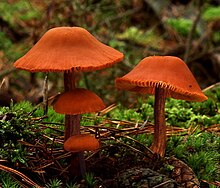Laccaria laccata
| Laccaria laccata | |
|---|---|
 |
|
| Scientific classification | |
| Kingdom: | Fungi |
| Division: | Basidiomycota |
| Class: | Agaricomycetes |
| Order: | Agaricales |
| Family: | Hydnangiaceae |
| Genus: | Laccaria |
| Species: | L. laccata |
| Binomial name | |
|
Laccaria laccata (Scop.) Cooke |
|
| Laccaria laccata | |
|---|---|
| Mycological characteristics | |
| gills on hymenium | |
|
|
cap is convex or flat |
|
|
hymenium is adnate or decurrent |
| stipe is bare | |
| spore print is white | |
| ecology is mycorrhizal | |
|
|
edibility: edible but not recommended |
cap is convex
hymenium is adnate
edibility: edible
Laccaria laccata, commonly known as the deceiver, or waxy laccaria, is a white-spored species of small edible mushroom found throughout North America and Europe. It is a highly variable mushroom (hence “deceiver”), and can look quite washed out, colorless and drab, but when younger it often assumes red, pinkish brown, and orange tones. The species is often considered by mushroom collectors to be a “mushroom weed” because of its abundance and plain stature.
The deceiver was first described by Tyrolian naturalist Giovanni Antonio Scopoli in 1772 as Agaricus laccatus, before being given its current binomial name by Mordecai Cubitt Cooke in 1884. The specific epithet is derived from the Latin adjective laccatus “varnished” or “shining”.Clitocybe laccata is an old alternative name. Var. pallidifolia, described by Charles Horton Peck, is the commonest variety found in North America.
It is the type species of the cosmopolitan mushroom genus Laccaria; where their relations lie among the gilled mushrooms is unclear, but they are currently classified in the family Hydnangiaceae.
The deceiver gets its common name from its variable appearance. Other names include lacklustre laccaria, and, by the Zapotec people, Beshia ladhi biinii (also the name of other members of Laccaria).
The deceiver is a small mushroom with a cap up to 6 cm (2.5 in) in diameter, convex when young and later flattening or even depressed in the center. It can be various shades of salmon pink, brick-red, or shades of orange or brown when moist or young, and duller and paler when dry. The fibrous stipe is 5–10 cm (2–4 in) high and 0.6–1 cm (0–0.5 in) wide. The irregular gills are widely spaced and decurrent or adnexed, and of similar color to the cap, though whiten with spores as the mushroom matures. The spore print is white, and the round spiny spores are 7–10 μm in diameter. The flesh is thin and has little taste.
...
Wikipedia
